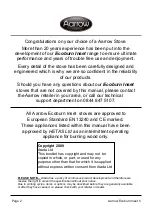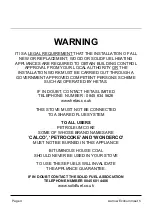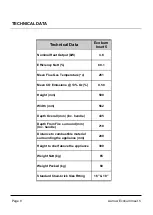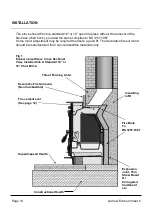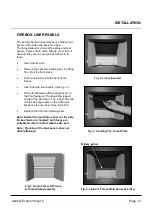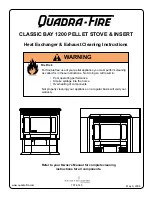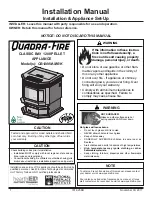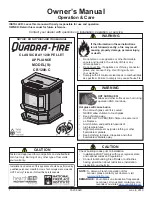
INSTALLATION
11
Aarrow Ecoburn Inset 5
FLUES AND CHIMNEYS
The flue draw is critical on any installation and
should be checked to ensure that it matches what
is specified. If it is higher than recommended,
provision must be made to correct the over draw.
The draw can vary in different weather conditions
and the customer should be made aware of this.
Failure to correct an over-drawing flue will
invalidate the warranty.
Please remember that chimney draught is
dependent on four main factors :
Flue gas temperature
Flue height
Flue size
Flue terminal
The stove must be connected to a suitable and
efficient flue that takes products of combustion
(fumes) from the stove outlet to the outside air. To
ensure a good up draught it is important that the
flue gases are kept warm and that the flue size
suits the stove. The termination of the outlet at the
top of the flue also needs to comply with Building
Regulations. The minimum effective height of the
flue must be at least 4.5 metres from the top of the
stove to the top of the flue outlet. When warm the
flue draught should be between 0.1 to 0.2 mb.
A chimney may comply with regulations but still be
subject to down draught and similar problems. A
chimney terminating above the ridge level is
generally less likely to suffer such problems.
If a new chimney is being provided it should fully
comply with the relevant Building Regulations that
specify the requirements for solid fuel burning
installations. Suitable types of chimney include the
following :
Masonry Chimney :
Built with clay or concrete
liners, or a chimney block system meeting Building
Regulations. These types of chimney should be
installed in accordance with the Building
Regulations and BS 6461:Part 1.
Factory Made Insulated Chimney :
Complying
with BS 4543:Part 2 (often called “Class 1
prefabricated metal chimney”). These types of
chimney should be installed in accordance with
Building Regulations and BS 7566: Parts 1 to 4.
Due to the gradual introduction of Europe Chimney
Standards, chimneys will be specified according to
their performance designation as defined in BS EN
1443 that covers the General Requirements for
chimneys. The minimum performance designation
required for use with solid fuel burning stoves is
T450 N2 S D3.
The flue and chimney installation must be carefully
checked by a competent person before fitting the
stove to ensure it is suitable and will work safely.
If the chimney is old (ie: built of brick or stone
without a liner) or being opened up for reuse
additional checks and smoke testing as described
in Appendix E of the Approved Document J 2002
Edition should also be carried out to ensure the
flue and chimney are in good operating condition.
Unless the existing flue is in good condition with
suitable access for collection and removal of
debris. If the flue size is more than 225mm (9”)
diameter or 200mm (8”) x 200mm (8”) square, a
suitable lining of 150mm (6”) diameter should be
fitted, or if the flue length is over 5.5 metres one
size larger than the appliance outlet should be fit-
ted. This should be a double skin stainless steel
flexible liner that is independently certified for use
with solid fuel. Details of suitable linings for use
with wood & solid fuel are given in the Official
HETAS guide that can be viewed on their website
at www.hetas.co.uk.
It is also important that suitable flue pipe complying
with the Building Regulations is used to connect
the stove to the flue in the chimney and that suit-
able access is provided into the flue for regular
inspection and sweeping of the flue ways.
The installer should comply with Building Regula-
tions requirements in respect of providing a Notice
Plate giving details on the chimney, flue lining,
hearth and fireplace installation. Approved Docu-
ment J of the Building Regulations for England &
Wales is available from The Stationery Bookshops
and can also be viewed at the ODPM website at
www.safety.odpm.gov.uk/bregs/brads.htm.
Details on the relevant Building Regulations and
BS British Standards are given in the “ General
Precautions” section of these instructions.
Chimneys should be as straight as possible.
Horizontal runs should be avoided.


